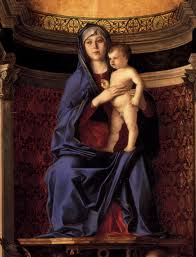July 24. The apartment is fine and our landlord put in a new router. Bruce took a long , early morning walk from our apartment to the bus station, by vaporetto to Bastio, then up past the Coop (supermarket).
Our place is a few yards down to the right, across the alley from the Hotel Dallamorra. Note how clean the street is. The tied-up plastic bags are out for garbage collection -- a daily event with special days for recyclable categories. Below, also, is a garbage barge.
Package deliveries.

Most of this is done by the time the tourists come out. The neighborhood is very beautiful, but we are getting a lot of mosquito bites.
Today we saw the St. Rocco complex. The Scuola charges 10 euros, but the restoration of the decorations funded with our admissions is glorious. We learn that the Tintoretto paintings were not nearly as dark as they are now.
Here’s what it looked like:
All the painting is by Tintoretto. It always adds a lot to see the entirety of a integrated program in situ.
July 25. Friday.
We went San Marco square, visited the basilica, and did some shopping. The Basilica remains marvelous. Sadly, the crowds require a set route that prevents one from seeing the church from the back of the nave. Much of the floor is covered, but its glory is still obvious. We were able to purchase a replacement for our badly damaged poster of the floor. It is only sold at the San Marco gift shop and, apparently, is not available online.
We chanced upon the old Olivetti showroom and store, which is now a small museum showing modern Italian artists and designers. It was designed by Carlo Scarpa in the late 50s.
This site has a lot of pictures:
We sat down at the Florian, but balked at the 24 euro music fee. So we had a drink on the North side of the Square, facing the Florian. The crowds had thinned and it was still pleasant to sit on the piazza for a Prosecco.
Dinner at da Silvio. A large garden setting. Branzino (sea bass) in salt case; veal with artichokes; grilled veggies; a rose from Trentino. Good meal. Poor service.
Saturday, July 26.
This morning, the Accademia, which is the main picture gallery for the older stuff. It is housed in a recycled scuola. This this the big entry room. Note the floors.

Here's a detail of a larger work by Venetian painter Marco Basaiti, around 1510. This is pretty much out of the Renaissance textbook, a showpiece of colors and perspective:

We "did" the Franciscan Basilica of Santa Maria Gloriosa dei Frari this afternoon. [Insert superlative.]
It is perhaps most famous for Titian's Assumption of the Virgin:
Or this Madonna by Giovanni Bellini (detail):
We were delighted with the carving of the choir:
Each stall is decorated with a carving and marquetry (close image not locatable).
Dinner across the street at Garofolo. Bruce pleased with fish soup; L had indifferent pesto spaghetti.
Tsk.



.JPG)